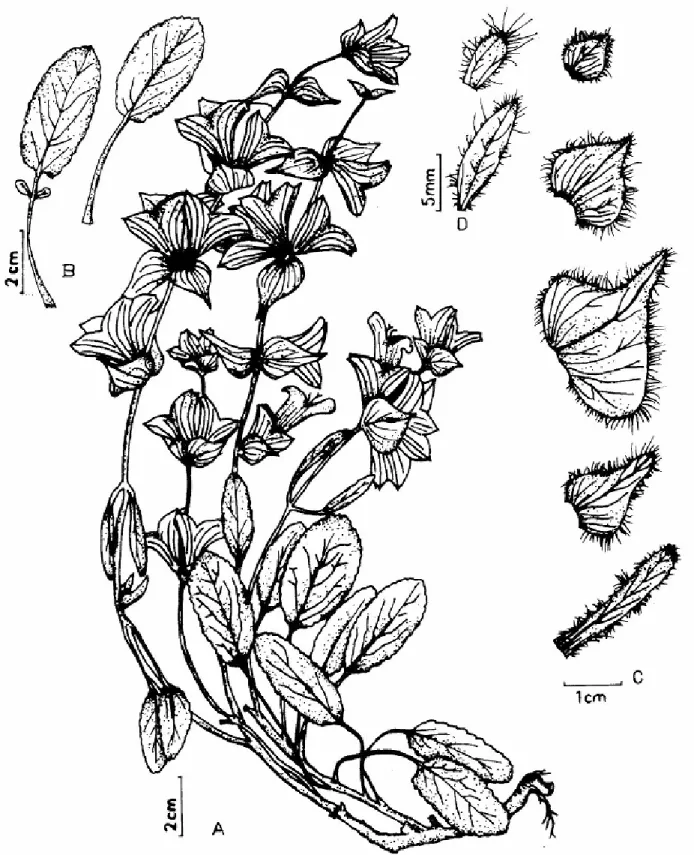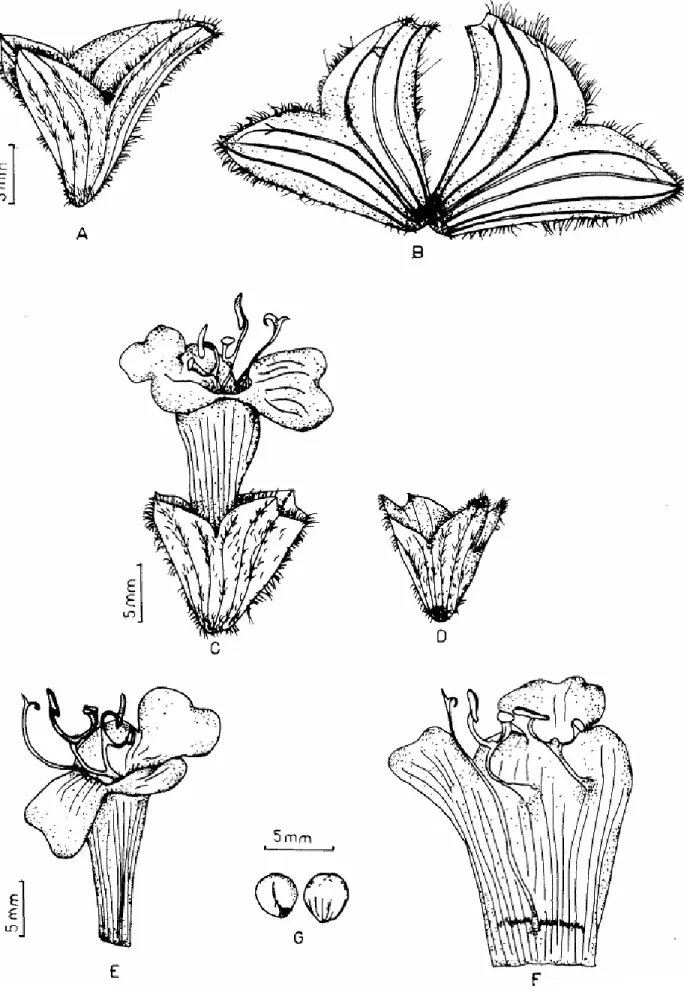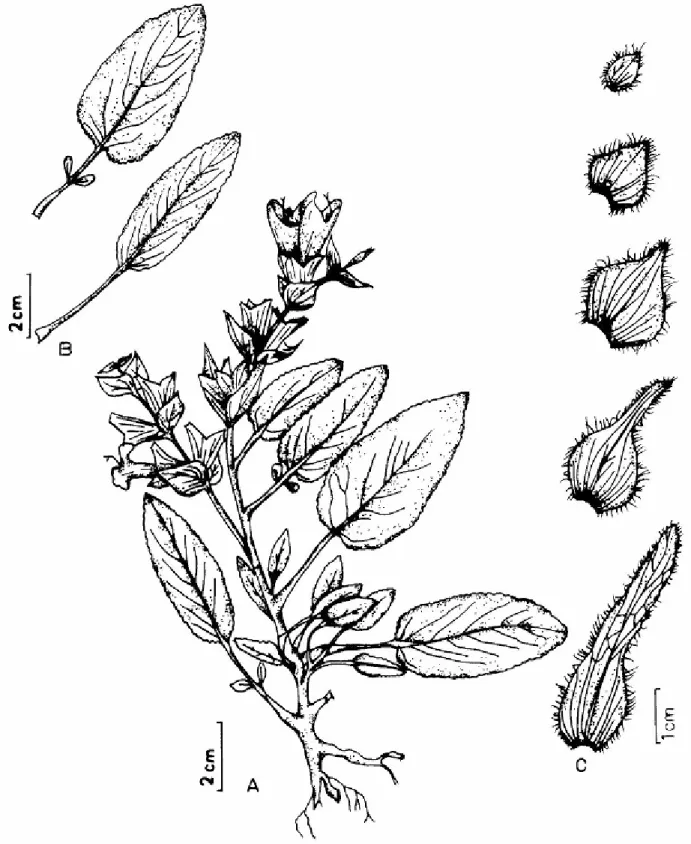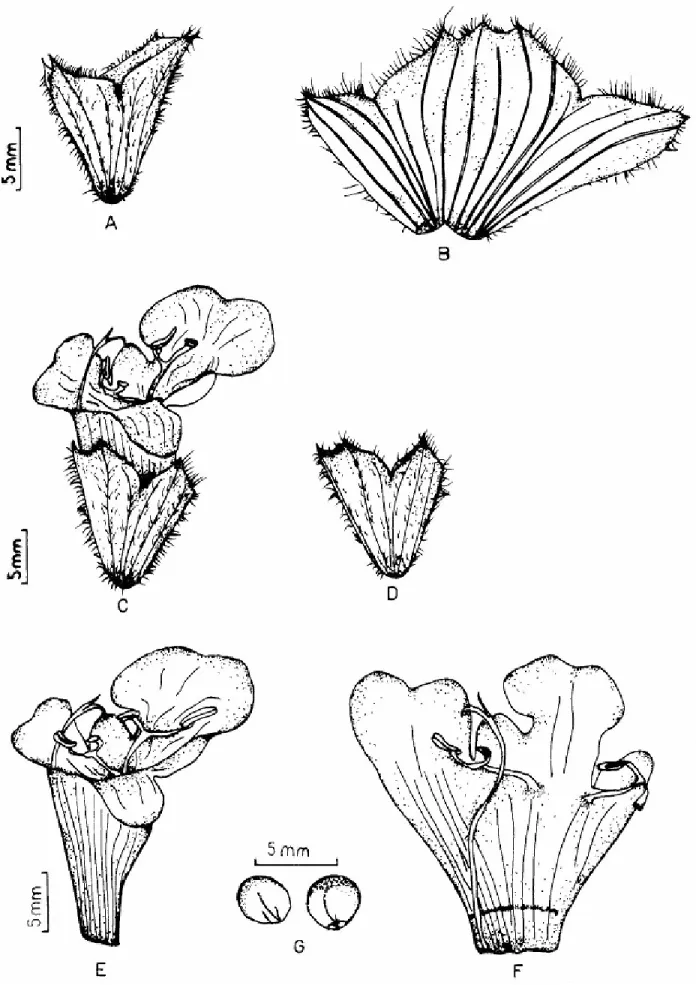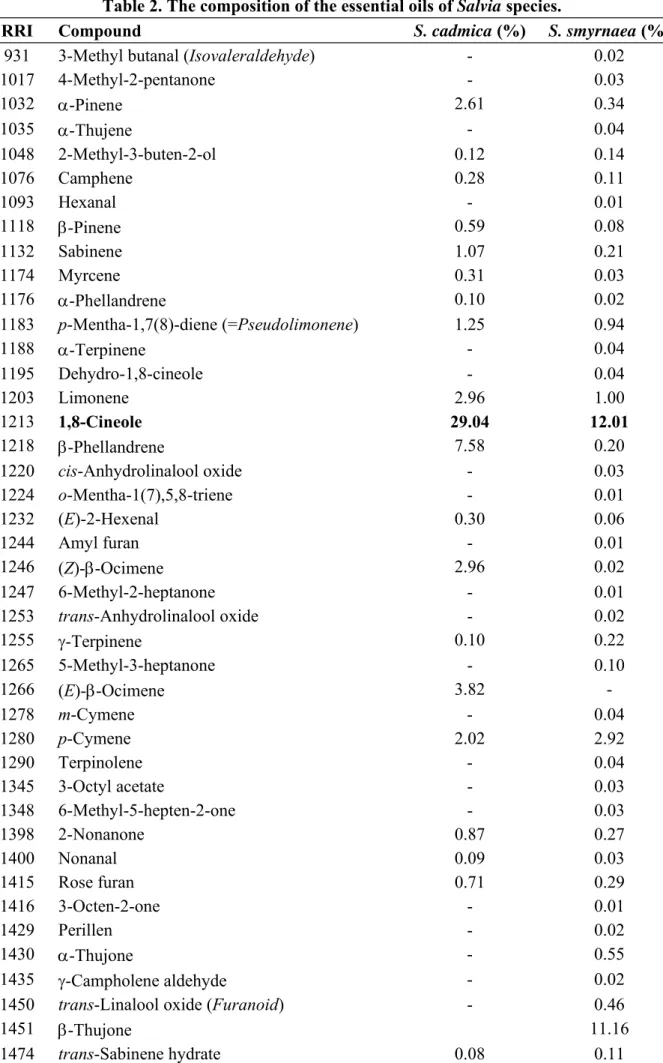Comparative morphological and phytochemical characterization of Salvia
cadmica Boiss. and S. smyrnaea Boiss.
Article in Pakistan Journal of Botany · August 2009
CITATIONS
6
READS
189 5 authors, including:
Some of the authors of this publication are also working on these related projects: Lamiaceae symposium : http://www.lamiaceae2017.org/ View project
BagBahce Dergisi View project K. Husnu Can Baser Near East University
1,177PUBLICATIONS 17,089CITATIONS SEE PROFILE M. Kurkcuoglu Anadolu University 240PUBLICATIONS 3,072CITATIONS SEE PROFILE Fatih Satil Balikesir University 84PUBLICATIONS 1,074CITATIONS SEE PROFILE Gülendam Tümen Balikesir University 192PUBLICATIONS 2,485CITATIONS SEE PROFILE
All content following this page was uploaded by K. Husnu Can Baser on 06 June 2014. The user has requested enhancement of the downloaded file.
Pak. J. Bot., 41(4): 1545-1555, 2009.
COMPARATIVE MORPHOLOGICAL AND PHYTOCHEMICAL
CHARACTERIZATION OF SALVIA CADMICA
AND S. SMYRNAEA**
KEMAL HÜSNÜ CAN BAŞER
1, BETÜL DEMIRCI
1, MINE KÜRKÇÜOĞLU
1,
FATIH SATIL
2*AND GÜLENDAM TÜMEN
21Department of Pharmacognosy, Faculty of Pharmacy, Anadolu University, 26470-Eskişehir, Turkey, 2Department of Biology, Faculty of Science & Arts, Balıkesir University, 10145 Balıkesir, Turkey.
Abstract
Salvia cadmica Boiss., and S. smyrnaea Boiss., (Lamiaceae) differ from each other by the colour of their corolla in that the former is white and the latter is violet-blue, and that calyx widens in fruit in the latter. Both species are characterized by having cryptone in their essential oils as major constituent. Both species are endemic to Turkey. The paper compares morphological and chemical features of the two species with a view to confirm their taxonomical status.
Introduction
The genus Salvia L., (Lamiaceae) is represented in Turkey by 95 species and
(Hedge, 1982; Davis et al., 1988; Adıgüzel & Vural, 1996; Dönmez, 2001; Behcet and
Avlanmaz, 2009; Celep et al., 2009). The ratio of endemism in the genus Salvia in
Turkey is ca. 50 %. Many Salvia species are aromatic, rich in essential oils and of
potential economic interest besides their ornamental uses. Salvia officinalis L., and S.
fruticosa Miller (Syn. S. triloba L.) are commonly used as herbal tea, food flavour and as
sources of essential oil. They are utilized mainly in food, cosmetic, perfumery and
pharmaceutical industries. Previously, we reported the essential oil composition of
several Salvia species (Başer et al., 1993; 1995; 1996; 1997; 1998; Tümen et al., 1998).
Salvia cadmica Boiss., and S. smyrnaea Boiss., are two endemic species of Turkey
with close taxonomical similarity. While S. cadmica grows in central and western
Anatolia, S. smyrnaea has a narrower distribution growing in an area adjoining Izmir and
Aydın provinces in western Turkey. The present report gives an account of the
morphological features and essential oil compositions of these species in order to provide
further proof to their taxonomical status.
To the best of our knowledge, this is the first report on the essential oil compositions
of S. cadmica and S. smyrnaea.
Materials and Methods
Plant materials: The aerial parts of S. cadmica were collected in June 1995 from
Eskişehir: Çatacık and the aerial parts of S. smyrnaea were collected in June 1998 from
Izmir: Selçuk in Turkey at an altitude of 1400-1500 m. Voucher specimens are kept at the
Herbarium of the Faculty of Pharmacy of Anadolu University in Eskişehir, Turkey
(ESSE: 11288 and 12723, respectively).
*Corresponding author E-mail: fsatil@balikesir.edu.tr, fsatil@gmail.com Phone: ++ 90-266-6121278; Fax: ++ 90-266-6121215
Morphological studies: Morphological features were determined on herbarium materials
and living specimens. Olympus SZX12 Stereomicroscope with drawing tube were used in
morphological studies.
Distillation: Air-dried herbs of S. cadmica and S. smyrnaea were hydrodistilled for 3 h
using a Clevenger-type apparatus to yield 0.17 % and 0.41 % essential oils on dry weight
basis, respectively.
Gas chromatography mass spectrometry (GC/MS): The essential oils were analysed
using a Hewlett-Packard G1800A GCD system. Innowax FSC column (60 m x 0.25 mm
Ø, with 0.25 μm film thickness). Helium (0.8 ml/min) was used as carrier gas. GC oven
temperature was kept at 60˚C for 10 min., and programmed to 220˚C @ of 4˚C/min., and
then kept constant at 220˚C for 10 min to 240˚C @ of 1˚C/min. Mass range was recorded
from m/z 35 to 425. Injections were applied splitless. Injection port temperature was at
250˚C. MS were recorded at 70 eV. Relative percentage amounts of the separated
compounds were calculated automatically from peak areas of the total ion
chromatogramme. Alkanes were used as reference points in the calculation of relative
retention indices (RRI). Library search was carried out using “Wiley GC/MS Library”
and in-house “Baser Library of Essential Oil Constituents”.
Results and Discussion
This study was aimed at comparing morphological and chemical features of the two
species with a view to establish further proof to their taxonomical identity.
Morphological features are shown in Figs. 1-4. S. cadmica and S. smyrnaea differ from
each other by the colour of their corolla in that the former is white and the latter is
violet-blue, calyx widens in fruit and bracteoles are absent in the latter. The differences between
S. cadmica and S. smyrnaea are summarized in Table 1.
Hydrodistilled essential oils of S. cadmica and S. smyrnaea were analysed by
GC/MS (Table 2). Sixty compounds representing 94.6% of the total oil were
characterized in the essential oil of S. cadmica, while 117 compounds representing 90.7%
of the total oil were identified in the essential oil of S. smyrnaea. Both species are
characterized by having cryptone (13.4% and 20.6%) and 1,8-cineole (29.0% and 12.0%)
in respective oils as major constituents. While cryptone (20.6%) was the main constituent
in the oil of S. smyrnaea, 1,8-cineole (29.0%) was the main component in the oil of S.
cadmica.
Although chemically quite similar, the two species have obvious morphological
differences which, beyond doubt, qualify them as distinct species.
CHARACTERIZATION OF SALVIA CADMICA AND S. SMYRNAEA
1547
CHARACTERIZATION OF SALVIA CADMICA AND S. SMYRNAEA
1549
Table 2. The composition of the essential oils of Salvia species.
RRI Compound S. cadmica (%) S. smyrnaea (%)
931 3-Methyl butanal (Isovaleraldehyde) - 0.02
1017 4-Methyl-2-pentanone - 0.03 1032 α-Pinene 2.61 0.34 1035 α-Thujene - 0.04 1048 2-Methyl-3-buten-2-ol 0.12 0.14 1076 Camphene 0.28 0.11 1093 Hexanal - 0.01 1118 β-Pinene 0.59 0.08 1132 Sabinene 1.07 0.21 1174 Myrcene 0.31 0.03 1176 α-Phellandrene 0.10 0.02 1183 p-Mentha-1,7(8)-diene (=Pseudolimonene) 1.25 0.94 1188 α-Terpinene - 0.04 1195 Dehydro-1,8-cineole - 0.04 1203 Limonene 2.96 1.00 1213 1,8-Cineole 29.04 12.01 1218 β-Phellandrene 7.58 0.20 1220 cis-Anhydrolinalool oxide - 0.03 1224 o-Mentha-1(7),5,8-triene - 0.01 1232 (E)-2-Hexenal 0.30 0.06 1244 Amyl furan - 0.01 1246 (Z)-β-Ocimene 2.96 0.02 1247 6-Methyl-2-heptanone - 0.01 1253 trans-Anhydrolinalool oxide - 0.02 1255 γ-Terpinene 0.10 0.22 1265 5-Methyl-3-heptanone - 0.10 1266 (E)-β-Ocimene 3.82 - 1278 m-Cymene - 0.04 1280 p-Cymene 2.02 2.92 1290 Terpinolene - 0.04 1345 3-Octyl acetate - 0.03 1348 6-Methyl-5-hepten-2-one - 0.03 1398 2-Nonanone 0.87 0.27 1400 Nonanal 0.09 0.03 1415 Rose furan 0.71 0.29 1416 3-Octen-2-one - 0.01 1429 Perillen - 0.02 1430 α-Thujone - 0.55 1435 γ-Campholene aldehyde - 0.02
1450 trans-Linalool oxide (Furanoid) - 0.46
1451 β-Thujone 11.16
CHARACTERIZATION OF SALVIA CADMICA AND S. SMYRNAEA
1553
Table 2. (Cont’d.).
RRI Compound S. cadmica (%) S. smyrnaea (%)
1478 cis-Linalool oxide (furanoid) - 0.24
1497 α-Copaene 0.99 - 1500 α-Campholene aldehyde - 0.37 1505 Dihydroedulane II * - 0.15 1522 2-Nonanol - 0.04 1532 Camphor 3.41 1.48 1541 Benzaldehyde - 0.05 1553 Linalool 0.57 0.40 1556 cis-Sabinene hydrate - 0.10 1565 Linalyl acetate - 0.25 1571 trans-p-Menth-2-en-1-ol 0.23 0.37 1586 Pinocarvone 0.09 0.06 1597 Bornyl acetate - 0.20 1602 6-Methyl-3,5-heptadiene-2-one 0.21 0.22 1604 2-Undecanone - 0.09 1611 Terpinen-4-ol 0.51 1.27
1614 Carvacrol methyl ether - 0.03
1624 cis-Dihydrocarvone - 0.02 1630 4-Terpinenyl acetate - 0.02 1638 cis-p-Menth-2-en-1-ol - 0.42 1639 cis-p-Mentha-2,8-dien-1-ol 0.26 - 1641 cis-β-Terpineol - 0.06 1642 Thuj-3-en-10-al - 0.29 1648 Myrtenal 0.19 0.10 1651 Sabina ketone - 0.96 1658 Sabinyl acetate - 0.10 1663 cis-Verbenol 0.32 0.06 1664 trans-Pinocarveol 0.53 0.35 1674 p-Mentha-1,5-dien-8-ol 0.08 0.03 1678 trans-p-Mentha-2,8-dien-1-ol - 0.19 1683 δ-Terpineol 0.22 0.18 1690 Cryptone 13.38 20.59 1700 p-Mentha-1,8-dien-4-ol (=Limonen-4-ol) - 0.08 1707 α-Terpineol 0.40 0.22 1709 α-Terpinyl acetate - 0.24 1720 trans-Sabinol - 0.40 1719 Borneol 0.36 0.81 1725 Verbenone 0.25 0.25 1740 trans-p-Menth-2-en-1,8-diol 0.30 0.09 1742 β-Selinene 0.36 1.38 1744 Phellandral 0.99 0.50 1748 Piperitone 0.21 0.26
Table 2. (Cont’d.).
RRI Compound S. cadmica (%) S. smyrnaea (%)
1751 Carvone 0.54 0.83 1758 cis-Piperitol 0.10 0.23 1765 Geranyl acetate 0.21 1.80 1797 p-Methyl acetophenone 0.10 0.19 1802 Cumin aldehyde 4.23 8.91 1804 Myrtenol 0.25 - 1810 trans-p-Mentha-1(7),8-dien-2-ol - 0.21 1811 p-Mentha-1,3-dien-7-al 0.50 0.90 1845 trans-Carveol 0.52 0.72 1857 Geraniol - 0.15 1864 p-Cymen-8-ol 0.43 1.00 1868 (E)-Geranyl acetone - 0.03 1882 cis-Carveol - 0.14 1896 cis-p-Mentha-1(7),8-diene-2-ol - 0.06 1912 p-Cymen-9-ol - 0.02 1940 α-Calacorene 0.09 - 1941 4-Isopropyl salicylaldehyde 0.12 0.26 1956 p-Isopropenyl benzaldehyde - 0.03 1958 β-Ionone - 0.02 1981 Cuminyl acetate - 0.15 2008 Caryophyllene oxide 0.70 0.47 2029 Perilla alcohol - 0.20 2073 p-Mentha-1,4-dien-7-ol 0.12 0.61 2084 Octanoic acid - 0.19 2113 Cumin alcohol 0.91 4.86 2144 Spathulenol - 0.01 2179 3,4-Dimethyl-5-pentylidene-2(5H)-furanone - 0.01 2192 Nonanoic acid - 0.25 2198 Thymol 0.31 0.28
2221 Isocarvacrol (=4-Isopropyl-2-methyl phenol) - 0.03
2239 Carvacrol 4.08 1.21 2241 p-Isopropyl phenol 0.27 1.68 2256 Cadalene 0.28 - 2257 β-Eudesmol - 0.14 2300 Decanoic acid - 0.17 2500 Pentacosane 0.09 - 2503 Dodecanoic acid - 0.21 2622 Phytol - 0.02 2700 Heptacosane - 0.03 2931 Hexadecanoic acid - 0.03 Total 94.6 90.7
RRI = Relative retention indices on a polar column *Tentative
CHARACTERIZATION OF SALVIA CADMICA AND S. SMYRNAEA
1555
References
Başer, K.H.C., B. Demirçakmak and N. Ermin. 1996. Essential oil of Salvia syriaca. Journal of Essential Oil Research, 8: 105-106.
Başer, K.H.C., H. Duman, M. Vural, N. Adıgüzel and Z. Aytaç. 1997. Essential oil of Salvia aytacii M. Vural et N. Adigüzel. Journal of Essential Oil Research, 9: 489-490.
Başer, K.H.C., M. Kürkcüoğlu and Z. Aytaç. 1998. Composition of the essential oil of Salvia euphratica Monbret et Aucher ex Benth. var. euphratica from Turkey. Flavour and Fragrance Journal, 13: 63-64.
Başer, K.H.C., S.H. Beis and T. Özek. 1995. Composition of the essential oil of Salvia cryptantha Monbret et Aucher ex Benth. from Turkey. Journal of Essential Oil Research, 7: 113-114. Başer, K.H.C., T. Özek, N. Kırımer and G. Tümen. 1993. The essential oil from Salvia pomifera L.
Journal of Essential Oil Research, 5 :347-348
Behçet, L. and D. Avlamaz. 2009. A new record for Turkey: Salvia aristata Aucher ex Benth. (Lamiaceae). Turkish Journal of Botany, 33: 61-63.
Celep, F., M. Doğan, A. Duran. 2009. A new record for the Flora of Turkey: Salvia viscosa Jacq. (Labiatae). Turkish Journal of Botany, 33: 57-60.
Davis, P.H., R.R. Mill and K. Tan. 1988. Flora of Turkey and the East Aegean Islands, Vol. 10. Edinburgh University Press, Edinburgh, p. 210.
Dönmez, A.A. 2001. A new Turkish species of Salvia L. (Lamiaceae). Botanical Journal of the Linnean Society, 137: 413-416.
Hedge, I.C. 1982. Salvia. In: Flora of Turkey and the East Aegean Islands, Vol. 7. (Ed.): P.H. Davis Edinburgh University Press, Edinburgh, pp. 400-461.
Tümen, G., K.H.C. Başer, M. Kürkcüoğlu and H. Duman. 1998. Composition of the essential oil of Salvia cedronella Boiss. from Turkey. Journal of Essential Oil Research, 10: 713-715.
Vural, M. and N. Adıgüzel. 1996. A new species from Central Anatolia: Salvia aytacii M. Vural N. Adıgüzel (Labiateae).Turkish Journal of Botany, 20: 531-534.
(Received for publication 13 June 2005)
View publication stats View publication stats
